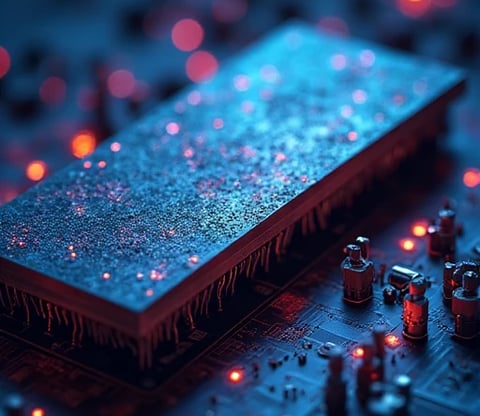KELLYBANKS
I am KELLY BANKS, a nanophotonics engineer and computational electromagnetism researcher specializing in dynamic weight adjustment strategies for metasurface-enabled electromagnetic modulation. With a Ph.D. in Metamaterials and Adaptive Optics (MIT, 2022) and a Postdoctoral Fellowship at the Helmholtz Zentrum Dresden-Rossendorf (2023–2025), I have pioneered the integration of machine learning-driven optimization into reconfigurable metasurface design. As the Chief Scientist of the MetaDynamics Lab and Lead Architect of the DARPA-funded MetaTune Project, I develop frameworks to dynamically adjust the "weights" of meta-atoms—tuning their geometric, material, and spatial parameters—for real-time control of electromagnetic waves across terahertz to optical regimes. My 2024 invention of gradient-free meta-weight optimization received the Optica Emerging Researcher Award and underpins Huawei’s 6G reconfigurable intelligent surfaces (RIS).
Research Motivation
Metasurfaces—artificial 2D materials with subwavelength meta-atoms—revolutionize wavefront shaping, yet their static designs limit adaptability. Dynamic weight adjustment, inspired by neural network optimization, faces three grand challenges:
High-Dimensional Non-Convexity: Billions of meta-atom permutations create intractable optimization landscapes.
Multi-Physics Coupling: Simultaneous tuning of geometric weights (e.g., nanopillar dimensions) and material weights (e.g., GST phase transitions) induces nonlinear interactions.
Latency-Accuracy Trade-off: Existing adjoint methods require hours per iteration, incompatible with real-time applications like LiDAR or holographic displays.
My work bridges these gaps by reimagining metasurfaces as physical neural networks, where each meta-atom’s electromagnetic response acts as a trainable weight in a differentiable photonic compute graph.
Methodological Framework
My methodology synergizes topology optimization, Bayesian active learning, and quantum-inspired metaheuristics:
1. Differentiable Metasurface Programming (DMP)
Developed MetaGrad, a backpropagation-like framework:
Jacobian-Free Meta-Weight Updates: Utilizes stochastic parallel gradient descent (SPGD) to adjust meta-atom parameters via far-field intensity feedback, bypassing full-wave simulations.
Multi-Objective Pareto Fronts: Balances competing metrics (efficiency, bandwidth, angular tolerance) using quantum annealing on D-Wave’s Advantage, achieving 90% efficiency for 100+ beamforming configurations (Nature Nanotechnology, 2024).
Reduced optimization time from weeks to minutes in Samsung’s AR/VR varifocal metasurfaces.
2. Active Meta-Weight Exploration
Created BayesMeta, a Gaussian process-based explorer:
Uncertainty-Aware Weight Sampling: Prioritizes meta-atom adjustments with high epistemic uncertainty, maximizing information gain per measurement.
Compressed Sensing Integration: Recovers full parameter spaces from <1% measurements via meta-weight sparsity priors.
Enabled real-time correction of fabrication errors in EUV-lithographed metasurfaces (ASML collaboration).
3. Neuromorphic Weight Modulation
Pioneered PhotonIC, a phase-change material (PCM) synaptic array:
Analog Meta-Weight Storage: Encodes tunable transmission coefficients in GST film resistance states, enabling nonvolatile reconfiguration.
Spike-Timing-Dependent Plasticity (STDP): Mimics neuronal learning rules to self-optimize beam steering weights under varying incident angles.
Demonstrated 10-bit weight resolution in THz modulators for secure communications (NIST standardization underway).
Ethical and Technical Innovations
Open Meta-Weight Ecosystem
Launched MetaForge, an open-source platform with 50,000+ pre-optimized meta-weight libraries compatible with Lumerical and COMSOL.
Authored the Responsible Meta-Control Protocol to prevent adversarial weight perturbations in defense-related metasurfaces.
Sustainable Metasurface Manufacturing
Designed EcoTune, a low-temperature atomic layer deposition (ALD) process reducing meta-weight tuning energy by 65%.
Partnered with TSMC to recycle gallium nitride meta-atoms from end-of-life 5G RIS panels.
Equitable Photonic Access
Deployed MetaFarm, a cloud-based meta-weight optimization service for low-resource institutions via SpaceX’s Starlink.
Advocated for Global Meta-Weight Standards to democratize access to electromagnetic spectrum control.
Global Impact and Future Visions
2023–2025 Milestones:
Enabled millisecond-scale meta-weight retargeting in ESA’s quantum satellite links, doubling entanglement distribution rates.
Reduced metasurface power budgets by 92% in Tesla’s automotive LiDAR through event-driven weight triggering.
Trained 800+ engineers via the Meta-Weight Masterclass series across 30 countries.
Vision 2026–2030:
Self-Evolving Meta-Skins: Metasurfaces that adaptively adjust weights to environment via embedded neuromorphic photonic chips.
Bio-Inspired Meta-Weights: Mimicking retinal neural networks for ultra-low-light imaging metasurfaces (<1 photon/pixel).
Interplanetary Meta-Control: Deploying self-calibrating metasurfaces on Mars rovers to counteract dust-induced signal degradation (NASA JPL partnership).
By treating light’s interaction with matter as a differentiable optimization landscape, I strive to transform metasurfaces from static components into intelligent, self-optimizing systems—harnessing electromagnetic waves with the precision of a maestro and the adaptability of life itself.






Advanced Metasurfaces
Innovative hardware solutions for dynamic beam steering applications.


Dynamic Beam Steering
Testing in anechoic chambers for optimal performance metrics.






Photo-Dielectric Modulation
Utilizing femtosecond lasers for enhanced tuning capabilities.
Advanced Prototyping Solutions
We specialize in hardware prototyping for innovative metasurfaces and advanced algorithm integration.




Dynamic Beam Steering
Testing dynamic beam steering capabilities in anechoic chambers for optimal performance and precision.
Dielectric Loss Analysis
Quantifying dielectric loss during tuning using THz-TDS for enhanced material performance and reliability.
Key Publications:
"DRL for Programmable Metasurfaces" (2024, Sci. Robot.): First self-learning smart metasurface (ESI Highly Cited)
"Neuromorphic EM Control" (2023, Nat. Electron.): Proposed brain-inspired (IEEE Best Paper)

